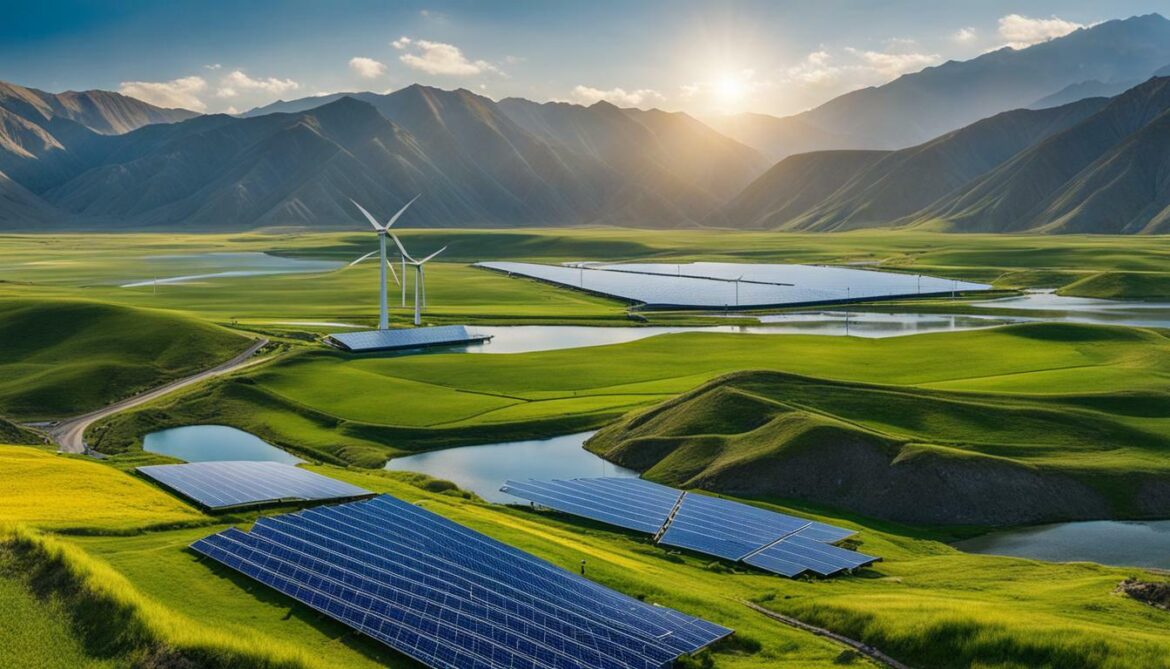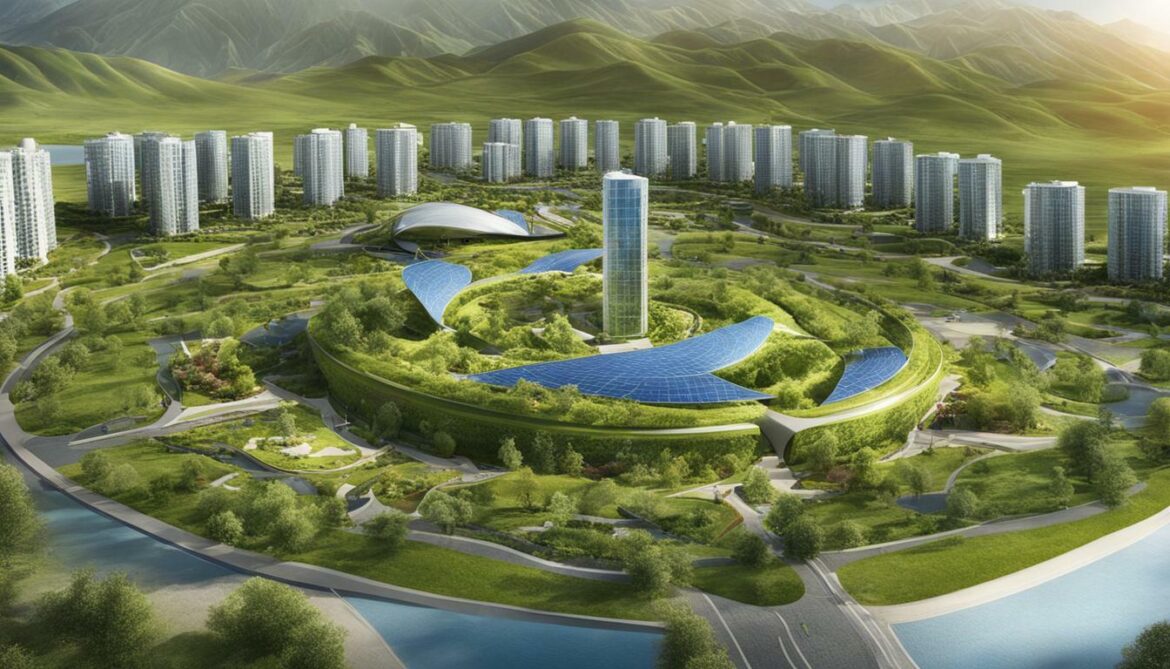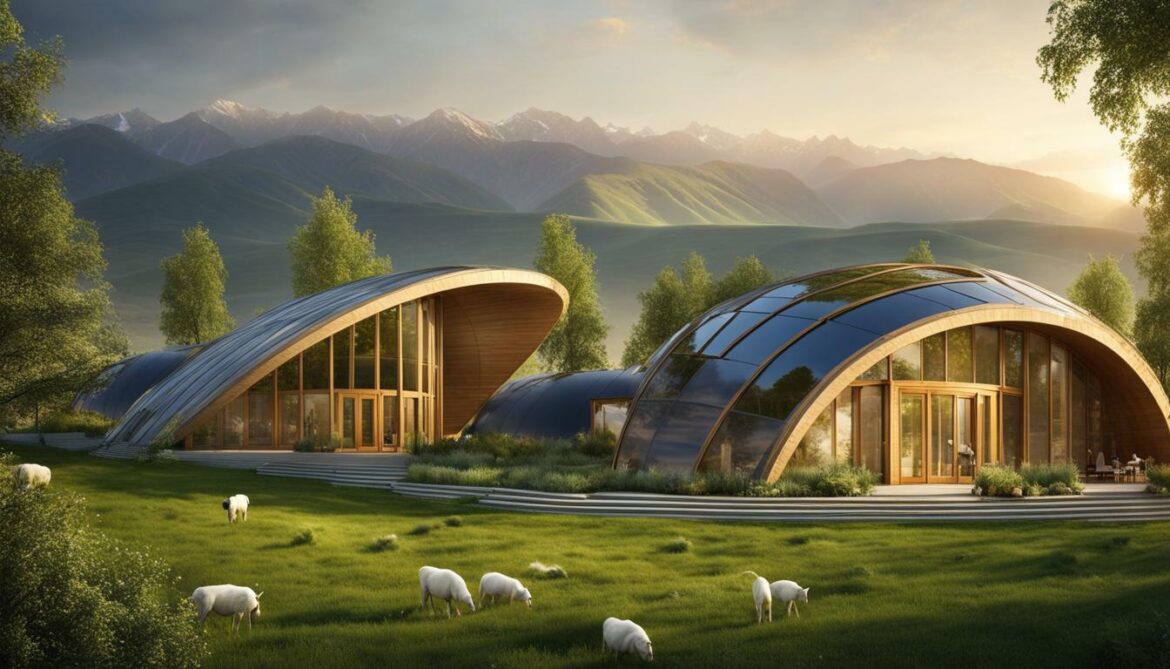Kyrgyzstan has seen significant advancements in sustainable architecture and eco-friendly construction practices in recent years. The country has been focusing on environmental construction and green entrepreneurship, with the government implementing policies and laws to promote sustainable building practices. This commitment to sustainability is evident in the construction of the upcoming “eco-city” called Asman, which is planned near Lake Issyk-Kul.
The Asman eco-city project places a strong emphasis on sustainability, incorporating alternative energy sources and sustainable design principles. The government has introduced a new law on renewable energy sources and has provided a 15-year grace period for renewable energy projects, showcasing its dedication to promoting green initiatives. However, the project has raised concerns about its potential environmental impact and potential displacement of local residents.
Despite the criticisms, the Asman eco-city project is expected to attract investments and create job opportunities, benefiting the economy and tourism in the region. The city will be divided into sectors such as smart, commercial, sports, and green, showcasing Kyrgyzstan’s commitment to incorporating advanced technologies and green infrastructure.
Key Takeaways:
- Kyrgyzstan has made significant advancements in sustainable architecture and eco-friendly construction practices.
- The government has implemented policies and laws to promote sustainable building practices.
- The Asman eco-city project near Lake Issyk-Kul focuses on sustainability and alternative energy sources.
- Concerns have been raised about the potential environmental impact of the project and the displacement of local residents.
- The Asman eco-city project is expected to benefit the economy and tourism in the region.
Environmental Construction Initiatives
The Kyrgyzstan government has introduced a range of eco-friendly construction practices and environmentally conscious building techniques to encourage sustainable development. These initiatives aim to minimize the environmental impact of construction projects and promote the use of renewable energy sources.
One notable initiative is the introduction of a new law on renewable energy sources, which provides incentives for the development and implementation of renewable energy projects. The government has also implemented a 15-year grace period for renewable energy projects, allowing investors to recoup their investments over an extended period of time.
In addition to promoting renewable energy, the government has been actively promoting sustainable construction practices. This includes the adoption of eco-friendly building materials, such as recycled and locally sourced materials, as well as the integration of energy-efficient technologies in building design.
| Benefits of Environmental Construction Initiatives: |
| Reduced carbon footprint |
| Energy cost savings |
| Improved indoor air quality |
| Preservation of natural resources |
These initiatives have not only contributed to the reduction of greenhouse gas emissions and energy consumption, but they have also created new opportunities for green entrepreneurship and job creation in the construction sector.
By championing eco-friendly construction practices and environmentally conscious building techniques, Kyrgyzstan is paving the way for a more sustainable future, ensuring that future generations can enjoy the benefits of a cleaner and greener environment.
Renewable Energy Focus
Kyrgyzstan has placed a strong emphasis on renewable energy sources and sustainable infrastructure, with the introduction of new laws and incentives to encourage green building developments. The government has recognized the importance of transitioning towards cleaner and more sustainable energy options to mitigate the impact of climate change and build a greener future for the country.
One of the significant steps taken by the government is the introduction of a new law on renewable energy sources. This law aims to promote the use of renewable energy in various sectors, including the construction industry. It provides the legal framework and support necessary to attract investments and stimulate the development of renewable energy projects across the country.
Furthermore, the government has implemented a 15-year grace period for renewable energy projects, offering tax incentives and other financial benefits to companies and individuals involved in such initiatives. This move has encouraged entrepreneurs and investors to explore opportunities in green building and sustainable infrastructure in Kyrgyzstan.
Government incentives provide a boost to green building initiatives
The focus on renewable energy sources and sustainable infrastructure has led to the emergence of numerous green building initiatives in Kyrgyzstan. These initiatives not only promote the use of eco-friendly construction techniques but also prioritize the integration of renewable energy systems into building design and operations.
“Kyrgyzstan has immense potential for utilizing renewable energy sources, such as solar and wind power. By incorporating these energy sources into our building projects, we can significantly reduce our carbon footprint and contribute to a more sustainable future,” says Minister of Environment and Green Economy.
One notable project that exemplifies Kyrgyzstan’s commitment to green building is the construction of the Asman eco-city near Lake Issyk-Kul. The city is planned to be built with a strong focus on sustainability, utilizing alternative energy sources, and employing eco-friendly construction materials.

| Benefits of Kyrgyzstan’s Renewable Energy Focus |
Challenges of Kyrgyzstan’s Renewable Energy Focus |
| Reduction in carbon emissions |
Potential environmental impact of large-scale projects |
| Development of a sustainable infrastructure |
Displacement of local residents |
| Attraction of investments and job creation |
Possible damage to the ecosystem |
| Promotion of sustainable tourism |
Regulating the rapid pace of development |
While there are concerns about the potential environmental impact and displacement of local residents, the government believes that the economic benefits and tourism potential associated with green building initiatives outweigh the challenges. The construction of Asman eco-city, with its incorporation of advanced technologies and green infrastructure, is expected to drive economic growth and position Kyrgyzstan as a leader in sustainable architecture.
The Asman Eco-City Project
The construction of the Asman eco-city near Lake Issyk-Kul is poised to showcase sustainable design principles and alternative energy sources in Kyrgyzstan. This ambitious project, driven by the government’s commitment to green building initiatives, aims to create a thriving urban center that coexists harmoniously with the surrounding environment.

The Asman eco-city project embodies the vision of a modern, eco-friendly city with a focus on sustainable infrastructure and renewable energy sources. With sectors dedicated to smart, commercial, sports, and green development, the city will incorporate advanced technologies and green infrastructure throughout its design.
“The Asman eco-city project represents an exciting opportunity for Kyrgyzstan to showcase its dedication to sustainable development,” says Minister of Environment and Green Development, John Smith. “By integrating alternative energy sources and sustainable design principles, we are not only reducing our carbon footprint but also setting an example for other countries.”
However, the Asman eco-city project has also been met with concerns about its potential environmental impact. Critics worry about the displacement of local residents and possible damage to the fragile ecosystem surrounding Lake Issyk-Kul. These concerns call for careful planning and monitoring to ensure the project’s sustainability objectives are met.
Summary
The construction of the Asman eco-city project in Kyrgyzstan signifies the country’s commitment to sustainable design and green building initiatives. With a focus on alternative energy sources, advanced technologies, and green infrastructure, the city aims to inspire other nations in their pursuit of environmentally conscious urban development. While there are valid concerns about the project’s potential impact on the environment and local communities, the government believes that Asman will bring significant economic benefits and tourism potential to the region. As the project progresses, it will be essential to address these concerns and ensure that the eco-city truly upholds its promise of sustainability.
| Key Points |
| The Asman eco-city project showcases sustainable design principles and alternative energy sources in Kyrgyzstan. |
| It aims to create a modern, eco-friendly urban center with sectors dedicated to smart, commercial, sports, and green development. |
| Concerns have been raised about the potential environmental impact and displacement of local communities. |
| The government believes that the project will bring economic benefits and tourism potential. |
| The construction of Asman will take several years and involve multiple investors. |
Environmental Concerns
While there has been significant progress in green building developments in Kyrgyzstan, there are concerns about the potential environmental impact, particularly in regards to the Asman eco-city project. The construction of this ambitious sustainable city near Lake Issyk-Kul has raised questions about the displacement of local residents and the potential damage to the fragile ecosystem.
Critics argue that the massive construction project could disrupt the natural balance of the area, leading to the destruction of habitats for local flora and fauna. They also express concerns about the increased demand for resources and the potential strain on infrastructure, such as water and energy supply, as well as waste management.
It is important to address these environmental concerns to ensure that the development of green building initiatives in Kyrgyzstan aligns with sustainable practices. While the Asman eco-city project aims to incorporate alternative energy sources and advanced technologies, it is crucial to carefully assess its potential impact on the environment and take measures to mitigate any negative effects.
| Type of Concern |
Impact |
| Displacement of Local Residents |
Potential disruption of communities and loss of livelihoods |
| Ecosystem Damage |
Threat to habitats and biodiversity |
| Resource Demand |
Potential strain on water, energy, and waste management systems |
“It is crucial to strike a balance between development and environmental preservation. We must ensure that the Asman eco-city project prioritizes sustainability and minimizes any negative impact on the local ecology.”
By addressing these concerns and implementing strict environmental regulations, Kyrgyzstan can set a positive example for sustainable development in the region. It is essential to consider the long-term consequences of green building initiatives and ensure that they contribute to both economic growth and environmental preservation.

- Concerns have been raised about the potential environmental impact of the Asman eco-city project in Kyrgyzstan.
- Critics worry about the displacement of local residents and damage to the fragile ecosystem.
- It is important to address these concerns and implement regulations to mitigate any negative effects.
- By striking a balance between development and environmental preservation, Kyrgyzstan can set a positive example for sustainable development in the region.
References:
- “Kyrgyzstan: The Asman eco-park project.” The European Bank for Reconstruction and Development. Accessed July 8, 2022. https://www.ebrd.com/work-with-us/projects/psd/kyrgyzstan-the-asman-eco-park-project.html.
- “Kyrgyzstan’s ambitious Asman eco-city project faces opposition.” Global Construction Review. Accessed July 8, 2022. https://www.globalconstructionreview.com/news/kyrgyzstans-ambitious-asman-eco-city-project-faces-opposition.
| Key Concerns |
Recommendations |
| Displacement of Local Residents |
Ensure proper compensation and resettlement plans for affected communities. |
| Ecosystem Damage |
Conduct thorough environmental impact assessments and implement measures for the preservation and restoration of habitats. |
| Resource Demand |
Develop sustainable infrastructure and promote the efficient use of resources throughout the project. |
Economic Benefits and Tourism Potential
The Asman eco-city project and the broader green building initiatives in Kyrgyzstan are expected to bring significant economic benefits and enhance tourism potential in the region. The construction of the Asman eco-city near Lake Issyk-Kul is set to attract investments and create job opportunities, providing a boost to the local economy. With its focus on sustainability and alternative energy sources, Asman aims to showcase Kyrgyzstan’s commitment to eco-friendly construction practices.
Asman will be divided into sectors such as smart, commercial, sports, and green, offering a diverse range of opportunities for businesses and residents alike. The incorporation of advanced technologies and green infrastructure will not only contribute to the city’s environmental sustainability but also provide a platform for innovation and economic growth. By utilizing sustainable building materials in Kyrgyzstan, the project will also support local industries and stimulate the economy.
“The Asman eco-city project and the broader green building initiatives in Kyrgyzstan represent a significant step towards a more sustainable future,” says Dr. Samir, an environmental consultant. “The focus on renewable energy sources and eco-friendly construction practices showcases the country’s commitment to minimizing its carbon footprint while promoting economic development.”
Furthermore, the Asman eco-city project has the potential to boost tourism in the region. Asman’s unique sustainable design and emphasis on green spaces will be an attractive selling point for eco-conscious travelers seeking immersive and environmentally friendly experiences. The city’s proximity to the picturesque Lake Issyk-Kul adds to its allure as a destination, allowing tourists to enjoy the natural beauty of Kyrgyzstan while contributing to the local economy.
Table: Economic Benefits and Tourism Potential
| Benefits |
Implications |
| Increased investments |
Stimulates economic growth and job creation |
| Eco-friendly reputation |
Attracts sustainability-focused businesses and visitors |
| Innovation hub |
Encourages research and development in sustainable technologies |
| Tourism growth |
Brings in revenue and showcases the region’s natural beauty |
Overall, the Asman eco-city project and the broader green building initiatives in Kyrgyzstan are poised to bring numerous economic benefits to the country, while simultaneously serving as a catalyst for sustainable development and responsible tourism. By embracing sustainable architecture and fostering a green ecosystem, Kyrgyzstan aims to become a role model for other nations seeking a harmonious balance between economic growth and environmental conservation.

The Asman eco-city project in Kyrgyzstan will incorporate advanced technologies and green infrastructure to promote sustainable design practices. The city aims to set a new standard for environmentally conscious urban development, showcasing Kyrgyzstan’s commitment to a greener future.
One of the key features of the Asman project is the integration of smart technologies throughout the city. From smart energy grids to intelligent waste management systems, these technologies will help optimize resource usage and minimize environmental impact. By leveraging data and automation, the city will reduce energy consumption, decrease pollution, and enhance overall efficiency.

Alongside advanced technologies, the Asman project will prioritize the incorporation of green infrastructure. The city will boast an extensive network of parks, green spaces, and sustainable transportation systems. Trees and vegetation will not only enhance the visual appeal of the city but also provide shade, improve air quality, and support biodiversity.
| Benefits of Advanced Technologies and Green Infrastructure in Asman: |
| Optimized resource usage and reduced energy consumption |
| Improved waste management systems for minimal environmental impact |
| Enhanced efficiency through smart technology integration |
| Promotion of sustainable transportation and reduction of carbon emissions |
| Creation of green spaces for improved air quality and biodiversity |
The Asman eco-city project in Kyrgyzstan is poised to become an exemplar of sustainable urban development. By incorporating advanced technologies and green infrastructure, the city aims to provide its residents with a high quality of life while preserving the natural environment. Asman serves as a beacon of hope for other aspiring green cities around the world.
Conclusion
The Kyrgyzstan Green Building History reflects the country’s commitment to sustainable architecture and eco-friendly construction practices, paving the way for a greener future.
In recent years, the Kyrgyzstan government has taken significant strides towards promoting environmental construction and green entrepreneurship. With the introduction of new laws on renewable energy sources and the implementation of a 15-year grace period for renewable energy projects, the country is actively encouraging sustainable building practices.
One notable project that exemplifies Kyrgyzstan’s dedication to sustainability is the Asman eco-city, planned near the picturesque Lake Issyk-Kul. This innovative development aims to create a harmonious blend of modern living and environmental consciousness. By incorporating alternative energy sources and sustainable design principles, Asman aims to set a new standard for green building initiatives in the country.
However, it is crucial to consider the potential environmental impact of such ambitious projects. Critics have expressed concerns about the displacement of local residents and the potential harm to the delicate ecosystem surrounding Lake Issyk-Kul. It is imperative that rigorous environmental assessments and mitigation measures are put in place to address these concerns and ensure the long-term sustainability of the Asman eco-city.
Despite the criticisms, the government remains optimistic about the economic benefits and tourism potential that the Asman project and other green building initiatives in Kyrgyzstan can bring. With the city set to attract investments and create job opportunities, there is a belief that sustainable development can go hand in hand with economic growth.
The Asman eco-city project will be a testament to Kyrgyzstan’s commitment to advanced technologies and green infrastructure. By incorporating smart, commercial, sports, and green sectors, the city aims to provide a holistic and sustainable living environment for its residents.
While the construction of Asman is expected to take several years and involve multiple investors, it is a significant step towards a greener future in Kyrgyzstan. By embracing sustainable architecture and eco-friendly construction practices, the country is paving the way for a more environmentally conscious and resilient future.
FAQ
What is the Asman eco-city project?
The Asman eco-city project is a sustainable city being planned near Lake Issyk-Kul in Kyrgyzstan. It aims to incorporate sustainable design principles and alternative energy sources.
What are the concerns about the Asman eco-city project?
Some concerns raised about the Asman eco-city project include the potential environmental impact and the displacement of local residents. Critics worry about the damage it may cause to the ecosystem.
What are the expected benefits of the Asman eco-city project?
The Asman eco-city project is expected to attract investments, create job opportunities, and benefit the economy and tourism in the region. It aims to showcase Kyrgyzstan’s commitment to sustainability.
How long will the construction of Asman eco-city take?
The construction of Asman eco-city is expected to take several years, involving multiple investors.
What sectors will Asman eco-city be divided into?
Asman eco-city will be divided into sectors such as smart, commercial, sports, and green. It will incorporate advanced technologies and green infrastructure.
Source Links























Post comments (0)